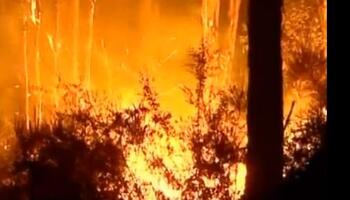
California fires continue to rage, yet no one wants to take responsibility for the unlimited “fuel” for the fires. Rather than addressing ways to reduce the amount of “fuel” awaiting the next spark, homeless campfire, or lightning strike, California Governor Newsom’s solution to prevent devastating wildfires is more litigation and reorganization of a utility company.
As to why we’ve accumulated so much fuel for fire and continue to allow its growth, it's a shared responsibility of several parties. Specifically, Federal regulations forbid forest management, builders continue to build wood framed tinder-box homes adjacent to the Federal stockpile of “fuel” for forest fires, and homeowners located in areas with all that “fuel” for the fire do little to fireproof their homes.
Obama-era forestry restructuring regulations from 2012 waylaid already established preventative maintenance measures that could have averted power outages and raging conflagrations resulting in the need for people to be relocated to safer grounds at the expense of the federal government.
Rather than taking responsibility for decades of policies that avoided safety precautions like careful and controlled burning, Governor Gavin Newsom is now blaming PG&E for not stepping up to solve the mess caused by decades of poor public and private management. But how will forcing PG&E to shoulder the entire financial burden of fire prevention and clean up after California wildfires reduce the fuel awaiting the next spark, or affect consumers?
The California Public Utilities Commission (CPUC) sets the rates that utility companies can charge their customers – not PG&E. Recently the CPUC granted the authority to all California utility companies to shut down services where it deems those services create a public hazard. In addition, Governor Newsom’s administration requires the utility to buy expensive and unreliable sources of alternative electricity that cost billions more than cheaper coal, nuclear power, and natural gas.
Today, electric utility companies throughout the state have all implemented Public Safety Power Shutoff (PSPS) events – aka rolling blackouts – as a last line of defense against possible massive wildfires caused by utility equipment in vulnerable communities. By definition a PSPS is limited to necessary areas, and only when risk assessment deems it absolutely required to protect life and property.
Power companies have done everything they can to oblige the state's liberal policies, from funneling billions of dollars into “renewable” wind and solar technology to shutting off power for millions of customers, severely cutting their bottom line. But they cannot be expected to fill the gap left behind by irresponsible leadership, especially when the money they’ve lost due to California’s “progressive” energy policies could have been dedicated to fireproofing efforts and better forest management.
California wants a modern grid to support the state’s goal of 100 percent renewable electricity; being unable to generate that electricity in-state, California already imports 29 percent of its electrical power from other states. The bad news is that imported electricity comes at higher costs and those costs are being borne by residents and businesses alike. California households are already paying 50 percent more, and industrial users are paying more than double the national average for electricity.
Imported electricity from other states can be expected to grow exponentially over the coming years as California shuts down its last zero emission nuclear generating plant at Diablo Canyon and closes three natural gas power plants in Southern California. These in-state closures will likely result in even steeper increases to electricity rates in the years ahead.
Governor Newsom is proud of his Wildfire Liability Bill, AB 1054 that requires rate payers – yes, you the public – to pay $10.5 billion into a new fund that utilities would be able to access if a fire caused by their equipment results in more than $1 billion in property damage! The State of California is developing the blueprint for a transformed utility. Consistent with AB 1054, PG&E must incorporate that blueprint into its bankruptcy plan. It's all about money for lawsuits, with no need to reduce any of the fuel that feeds the fires.
The bankruptcy judge overseeing PG&E’s perilous condition, largely caused by paying out billions of dollars in claims on wildfire damage of the past few years, has been treating the utility like it is a criminal enterprise. Instead of creating rulings that would allow them to extricate themselves from Chapter 11, Bankruptcy Judge Dennis Montali has been more interested in tacking additional claims costs on PG&E than helping the utility solve its financial problems.
PG&E safely maintains approximately 81,000 miles of overhead distribution lines and approximately 26,000 miles of underground distribution lines across its service area. PG&E’s electric transmission system is about 18,000 miles, the majority of which are overhead lines. Newer developments tend to have underground power, but at a cost of up to $3 million dollars per mile to convert overhead distribution to underground distribution, the cost to go underground for 81,000 miles would be almost $250 BILLION (Yes, that’s a “B”)!
For an administration trying to shirk blame, a big corporation makes the perfect scapegoat. But forcing our energy companies to take all the responsibility for decades of bad public and private policies will increase costs for everyone, pushing many Californians closer toward poverty and homelessness, and also disrupt power service, cutting access for millions.
It’s no wonder PG&E is bankrupt. If our current leadership has its way, the rest of the state will soon follow as the stockpile of fuel keeps growing to fuel that next fire.
This piece first appeared at CFACT.
Ron Stein is an engineer who, drawing upon 25 years of project management and business development experience, launched PTS Advance in 1995. He is an author, engineer, and energy expert who writes frequently on issues of energy and economics.












